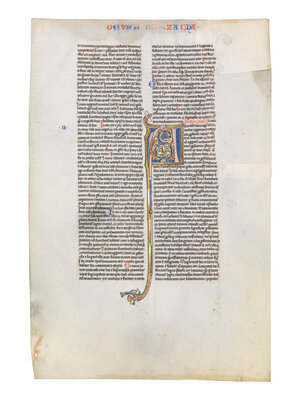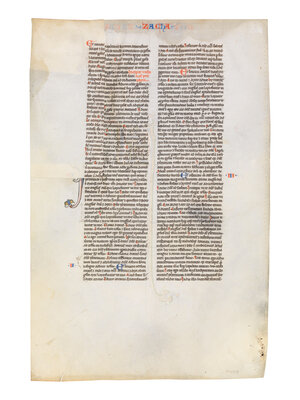Condition Report
Contact Information
Lot 13
ALMAGEST MASTER (active Paris, c. 1210-1220)
A leaf from a Bible, with an illuminated initial ‘A’, in Latin, illuminated manuscript on parchment [France, Paris, c. 1220]
A leaf from a Bible, with an illuminated initial ‘A’, in Latin, illuminated manuscript on parchment [France, Paris, c. 1220]
Sale 2033 - Western Manuscripts and Miniatures
Jun 27, 2024
10:00AM CT
Live / Chicago
Own a similar item?
Estimate
$2,000 -
3,000
Lot Description
ALMAGEST MASTER (active Paris, c. 1210-1220)
A leaf from a Bible, with an illuminated initial ‘A’, in Latin, illuminated manuscript on parchment [France, Paris, c. 1220]
A leaf from a Bible, with an illuminated initial ‘A’, in Latin, illuminated manuscript on parchment [France, Paris, c. 1220]
Considered one of the first lay artists, or ateliers, in Paris, the accomplished Almagest Master is noted for his modelling with transparent drapery on animated figures as on this exceptional miniature with rich goldleaf.
255 x 165 mm. Single leaf, modern pagination ‘496” and “497” in pencil in the lower outer corner, ruled in plummet for two columns of 57 lines (written space: c. 170 x 95 mm), with an extra rule in the top margin for the running titles, vertical bounding lines ruled full across, prickling for rules in the inner margin, written below top line in black ink in a formal gothic book hand, capitals touched with red, rubrics in red, versal initials, running titles, and chapter numbers alternately in red and blue, five two-line initials alternatively in red and blue with contrasting penwork extending into the margins, ONE LARGE TEN-LINE ILLUMINATED INITIAL in light brown with white highlights, on blue ground with white and orange dots, framed by acanthus scrolls highlighted in tooled burnished gold and with green edges, one stem of the initial in the shape of a winged monster, extending into the lower margin, infilled on burnished gold ground with a monster whose body is composed of intertwining foliage (another historiated? initial on the verso partially excised, the blank space carefully repaired by parchment fragment from the same parent manuscript, a sewn parchment repair in the lower inner edge, slight soiling and stains, tape stains on corners of verso, minor flaking of gold in the initial, else in good condition).
This leaf large comes from an early thirteenth-century Paris Bible that predates the standardization of chapter divisions and iconography of a typical Paris Bible. The leaf contains the end of Haggai and the beginning of Zechariah, reading on the recto from Haggai 1:8, “[ascendi]te in montem…,” followed by the prologue to Zechariah, “Anno secondo…,” to Zechariah 4:1 on the verso, “In die illa, dicit Dominus exercituum…” The prologue is introduced with an illuminated initial ‘A’, for “Anno,” on blue ground with white and orange dots, enclosed in acanthus scrolls highlighted in tooled burnished gold, with one of the letter’s stems forming a winged monster, and infill on burnished gold ground of another monster whose body is composed of intertwining foliage. The initial to Zechariah has been excised, with the loss of some text, and replaced with a piece of Mark 8 (recto) and 9 (verso).
The artist of these leaves was first defined by Francois Avril in 1976, who named him the Master of the Sorbonne Ptolemy, after a manuscript of Ptolemy’s Almagest which was in the library of the Sorbonne in the fourteenth century (now Paris, BnF, MS lat. 16200), and which has a colophon recording that it was copied from the exemplar of Saint-Victor, Paris, and finished in December 1213. Avril attributed the illumination of copies of a few other University texts to him, as well as that of several Bibles and glossed Bibles, which provide supporting evidence that he worked in Paris in the 1210s and 1220s.
Avril dedicated his article to the memory of the late Robert Branner, whose book on Parisian illumination was published posthumously the following year. Branner independently identified the Sorbonne Almagest as the artist’s masterpiece, and thus named him the Almagest Master, a name that has become more prevalent in Anglophone literature. A date for the present leaves before about 1230 is supported by the prickings in the inner margin, the green edging around the initials, and the pre-modern chapter divisions, while a date after about 1220 is suggested by the fact that the writing is below top line.
Provenance
(1) Bernard Quaritch Ltd, London, acquired in August 1996 by:
(2) Robert McCarthy, London, MS BM 1036.
Parent manuscript
1. Already very imperfect and mutilated when rebound in the 19th century. When a portion of 181 leaves and the binding were offered by Bloomsbury Auctions, 17 July 2014, lot 181, almost all the decorative elements had been removed. The remaining initials include St Jerome writing (f. 1), animals (f. 40), dragons (f. 65) and St John’s eagle (f. 161). One of the other sister leaves in the McCarthy collection bears a nineteenth-century binder’s quire number “26” in ink, and an indistinct pencil pagination, perhaps “534”. It thus seems likely that the volume was composed of quires mainly of twelve leaves (24 pages), and that more than 60 had already gone missing by the time of the 19th-century rebinding.
2. Perhaps owned in Germany, as the earliest currently known appearance of a leaf was in Heidelberg in the early 1980s.
3. Bernard Quaritch Ltd, c. 1988.
Sister leaves
Sister leaves in public collections include Boulder, University of Colorado, MSS 317, 318. Another two leaves and two bifolia are in the McCarthy collection published together with the present one in his catalogue as no. 16 (see below).
LITERATURE
On the present leaves as well as their parent manuscript and sister leaves, published: Sotheby’s London, 2 December 1997, lot 48; Christie’s London, 1 December 2015, lots 3 and 4; Bloomsbury Auctions London, 17 July 2014, lot 181; Peter Kidd, The McCarthy Collection, Vol. III, French Miniatures, London, 2018, no. 16, pp. 63-68 (with further literature).
We are grateful to Peter Kidd for permission to quote from his catalogue for this entry. Freeman’s | Hindman thank Senior Consultant Sandra Hindman and Elliott Adam for their assistance in preparing this sale.
The Collection of Robert McCarthy



